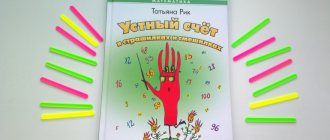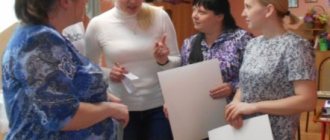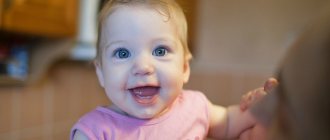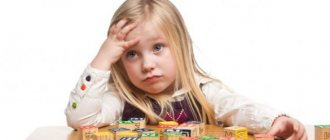Card index of games using TRIZ technology elements
Thumbelina is light, and the swallow is large;
Pierrot has long sleeves, and Malvina has blue hair, etc.
44. Eurorhythm is a fantasy technique in which a specific object is viewed according to plan:
1. Function and contradictions in a given object;
2. Options by which the object is presented (fantasizing: what options do not exist?);
3. Analysis of the situation: this object is the only one left on earth, what could be the consequences of this?;
4. Analysis of the situation: the object has disappeared, how will the function be performed?;
5. Analysis of the reasons in the situation: the object exists, but the function is not performed;
6. Inventing new objects by combining this object with others (can be arbitrary).
45. Circles of Lull.
The tool consists of several circles of different diameters strung on a common rod. An arrow is installed at the top of the rod. All circles are divided into the same number of sectors. The circles and arrow are movable. The free rotation of all parts leads to the fact that certain sectors on each of the circles appear under the arrow. The purpose of this manual: to clarify the knowledge of preschoolers in various subject areas; develop the variability of imaginary images. "Make a Word" - used to form words. “Color mixing” - consolidating the production of color and its shades. “Compose a fairy tale” - used to compose various versions of fairy tales.
46. Manual “Caterpillar”
forms the ability to compare objects according to several different characteristics. Compose riddles using signs presented in the form of visual symbols. Learn to classify objects according to these characteristics and compose descriptive stories.
47. "Magic Path"
The plot of many fairy tales is based on the actions of a hero: he travels for a specific purpose, interacts with other objects (overcomes obstacles, solves problems, while changing himself and changing objects of interaction), and can learn a lot.
48. “Didactic ball”
The “Didactic Ball” manual is actively used at a young age, with the help of which we teach children to find words - antonyms. Let's give an example of using the manual in different age groups. Tasks for children 4 years old. The teacher offers a word - a noun (adjective, verb), and the child says the opposite in meaning. Example: sadness - joy; White black; cry - laugh.
49. Manual “Clock”
Symbols for feature names were introduced gradually: from simple ones (color, shape, size) to more complex ones (temperature, weight, distance, smell, etc.). In the manuals, 17 names of characteristics were placed, and additional empty cells were left for the future. The manual became universal: it was used in different types of classes and as an algorithm for composing descriptive stories and riddles.
Presentation “Use of TRIZ technology in the speech development of preschool children”
#Publications #Application of technology #Methodologist #Educator #Preschool education
“Every child in his time is a true genius.” K. Chukovsky Using TRIZ Technology in the speech development of a preschool child. MBDOU B “Firefly” was performed by Gosteva O.A.
Two people were looking out the window. One saw rain and mud, the other saw green foliage and a blue sky. Two people were looking out the window...
One of the main indicators of the level of development of a child’s mental abilities can be considered the richness of his speech. The child’s ability to communicate, explore the world, and plan his actions is formed as his thinking develops. Modern psychological and pedagogical research has established that thinking and speech are interconnected and interdependent. In my teaching activities, I have encountered the problem that modern preschoolers have: *monologue speech is poorly developed; *some experience in storytelling; *insufficient active vocabulary; *children do not know the algorithm for composing a coherent story.
In this regard, for the speech development of children, I chose to use TRIZ (the theory of inventive problem solving) techniques in the educational process. About 50 years ago, this theory was created by a scientist, engineer, science fiction writer, organizer and teacher - Genrikh Saulovich Altshuller. TRIZ technology adapted for preschool age allows you to educate and train a child under the motto “Creativity in everything.”
The goals of TRIZ are not just to develop children’s imagination, but to teach them to think systematically, with an understanding of the processes taking place. The main task of TRIZ is not the communication of new knowledge, but teaching ways to independently obtain information, which is possible through search information, through organized collective reasoning, through games. Advantages of TRIZ: *develops fantasy and imagination in children; *instills self-confidence; *does not require much time; *can be used in the traditional teaching system.
TRIZ technology methods: *teaching children creative storytelling based on a picture; *working with contradiction; *teaching preschoolers how to compose logical stories based on a series of pictures; *teaching children to create different characteristics of objects; * teaching children writing and word creation; *teaching children how to compose fairy-tale texts.
Teaching children creative storytelling from a picture. When examining a painting, the following methodological techniques are used: *Game motivation “Magic Picture”, *Game “Spyglass”, *Game “Photography”, *Game “Entering the Picture”, *Game “Living Pictures”, *Game “Transformation” into the object in the painting."
Working with contradiction Contradiction is the presentation of opposing demands to one object. For example, the same object is good or bad (some people like the film, but others don’t), large and small (an icicle is first small, and then big), strong and weak (one match is weak, breaks easily, but it’s difficult to break many , they are strong. We solve the contradiction with the help of games: * “Say a lot about one subject.” * “If you were in a fairy tale...”, * “Magic wand - smart - shawl or magnifier”, * “What if...” .
Teaching preschoolers to compose logical stories based on a series of pictures Stages of working with a series of pictures: * Arrange individual pictures in the required logical sequence based on a given plot. *Compose a short coherent story of the plot. *Recognize and voice the rules for compiling a series of pictures.
Teaching children to create figurative characteristics of an object. Technology for teaching children how to make comparisons. *An object is named, *Its attribute is designated, *The value of this attribute is determined, *This value is compared with the value of the attribute in another object. For example: a chicken is the same yellow (attribute value) in color (attribute) as the sun.
Technology for teaching children how to write riddles. Basic models for composing riddles. *Which? Yellow, but not lemon, *What does it do? Hissing, but not a volcano, *What does it look like? Round, but not a ball. *What happens the same? Samovar *What (who) does the same? *What is the difference?
Teaching children word creation and writing. In my work, I use the following games and game exercises: * “Folding pictures” - teach how to match objects with images whose names rhyme, * “Come up with rhyming lines”, * “Come up with a rhyming word.”
Compiling fairy tales using the “Catalog” method. Goal: to teach the child to connect randomly selected objects into a single storyline, to develop the ability to compose a coherent fairy-tale text according to a model in which there are two heroes (positive and negative) who have their own goals, their friends who help them achieve these goals, a certain place. Algorithm for compiling a training: *A group of children is asked to compose a fairy tale using a picture or a toy. *A question is asked, the answer to which is in the box (a toy is taken out). *Children’s answers are collected into a single storyline. *Children come up with the name of the Fairy Tale. *Children retell the fairy tale.
“Collage of fairy tales” - inventing a new fairy tale based on fairy tales already known to children (creative collaboration between children and the teacher).
“Fairy tale inside out” - the game consists of “twisting” a fairy tale or turning a fairy tale theme “inside out”. Recall with the children a well-known fairy tale and suggest changing the character of its characters. Positive character to negative and vice versa. For example: “The grandmother is evil, but the wolf is kind,” “The fox is kind, the hare did not let her into his house.”
Results: The cognitive activity of children is activated. Creative thinking, imagination, and coherent speech develop. Children freely master the ability to compose logical and creative stories from pictures. Motivational guidelines for creativity are created. The child’s ability to create a new product of speech activity develops - a ready-made story, a fairy tale, a riddle.






